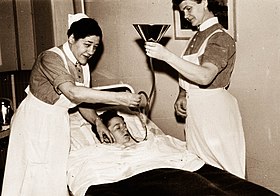| Insulin shock therapy | |
|---|---|
 Insulin shock therapy administered in Långbro Hospital, Stockholm in the 1930s | |
| ICD-9-CM | 94.24 |
| MeSH | D003295 |
Insulin shock therapy or insulin coma therapy was a form of psychiatric treatment in which patients were repeatedly injected with large doses of insulin in order to produce daily comas over several weeks.[1] It was introduced in 1927 by Austrian-American psychiatrist Manfred Sakel and used extensively in the 1940s and 1950s, mainly for schizophrenia, before falling out of favour and being replaced by neuroleptic drugs in the 1960s.[2]
It was one of a number of physical treatments introduced into psychiatry in the first four decades of the 20th century. These included the convulsive therapies (cardiazol/metrazol therapy and electroconvulsive therapy), deep sleep therapy, and psychosurgery. Insulin coma therapy and the convulsive therapies are collectively known as the shock therapies.
- ^ Neustatter WL (1948) Modern psychiatry in practice. London: 224.
- ^ Jones, K (2000). "Insulin coma therapy in schizophrenia" (PDF). Journal of the Royal Society of Medicine. 93 (3): 147–149. doi:10.1177/014107680009300313. PMC 1297956. PMID 10741319. Archived from the original (PDF) on 20 February 2009.